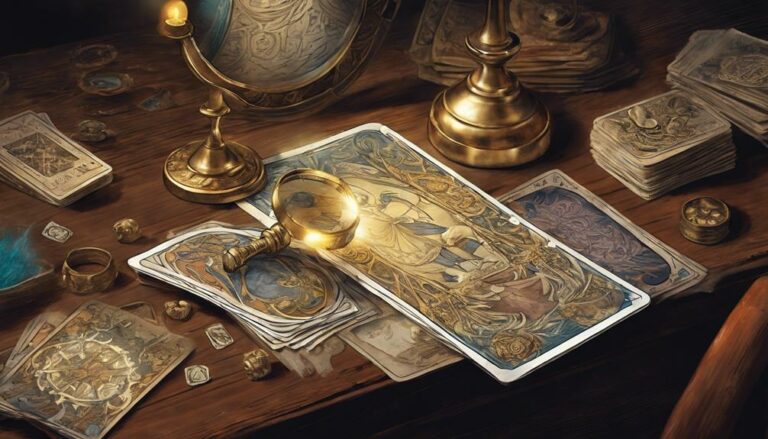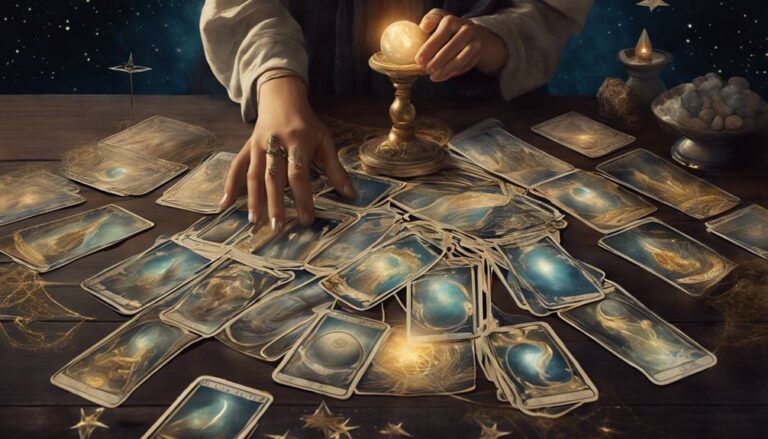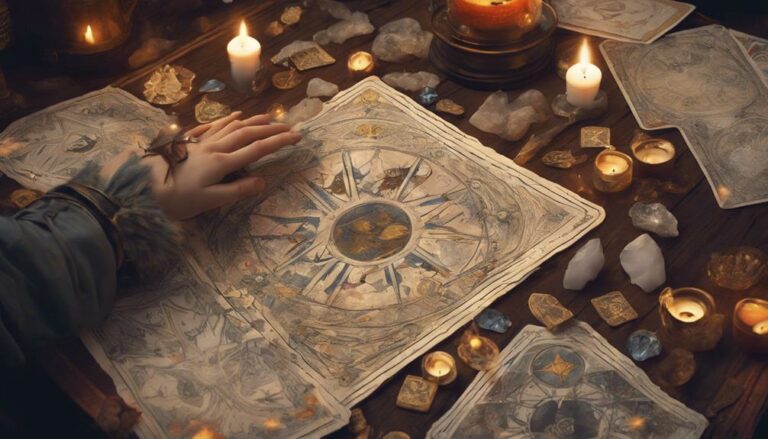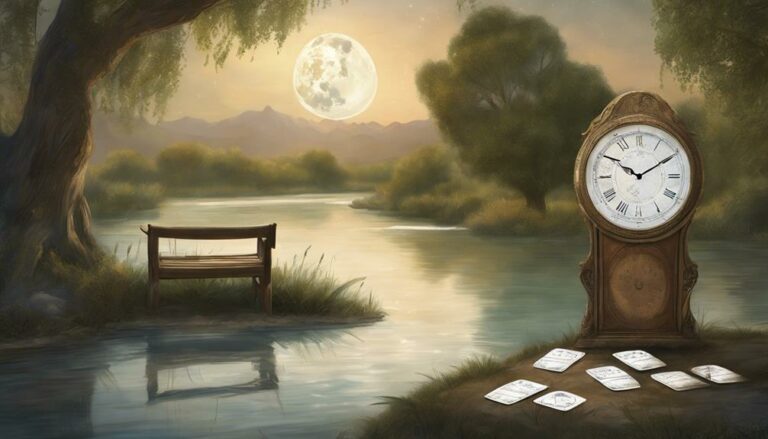As I delve into the fascinating world of tarot cards, I can’t help but marvel at the uncanny coincidences that seem to surround their historical uses in fortune-telling. From their origins as a tool for divination to their role in providing insight and prediction, tarot cards have long been intertwined with ancient symbolism. Join me on this journey as we explore the rich history of tarot cards and their significant cultural influences on fortune-telling practices throughout the ages.
Table of Contents
ToggleKey Takeaways
- Tarot cards have a long history and were initially used as playing cards before gaining significance in fortune-telling.
- Tarot card reading techniques involve shuffling and drawing cards, using different spreads and card combinations for interpretation.
- Tarot cards draw upon ancient myths, religions, and philosophies, and are divided into Major Arcana and Minor Arcana.
- Different cultures have their own interpretations and spreads for tarot card readings, incorporating cultural influences and symbolism.
Origins of Tarot Cards in Divination
You might be wondering where tarot cards actually come from and how they ended up being used for divination. Well, let’s dive into the origins of tarot cards and their connection to occult practices. Tarot cards have a rich history that dates back to the 15th century in Europe. Originally, they were used as playing cards, similar to the modern deck of playing cards we use today. However, it was during the 18th century that tarot cards started to gain significance in fortune-telling.
In the late 18th century, a French occultist named Antoine Court de Gébelin proposed that tarot cards held mystical and esoteric meanings. He believed that the imagery depicted on the cards had a deeper symbolism that could be used for divination purposes. This idea gained popularity, and tarot cards became associated with fortune-telling and occult practices.
Tarot cards’ historical significance in fortune-telling continued to grow in the 19th and 20th centuries. Various occultists and mystics, such as Arthur Edward Waite and Aleister Crowley, developed their own interpretations and systems of using tarot cards for divination. These interpretations became widely used and popularized the idea that tarot cards could provide insights into the past, present, and future.

Tarot Cards as a Tool for Insight and Prediction
To gain insight and make predictions, people often turn to tarot cards as a valuable tool. Tarot card reading techniques vary, but they typically involve shuffling and drawing cards from a deck with symbolic imagery. The interpretation of tarot cards is a complex process that requires both intuition and knowledge of the cards’ meanings.
Here are five key aspects of tarot card reading techniques and interpretation:
- Card spreads: Different spreads, such as the Celtic Cross or Three-Card spread, offer different insights and focus areas for the reading.
- Card combinations: The combination of multiple cards in a spread can provide deeper and more nuanced interpretations.
- Symbolic meanings: Each tarot card has its own symbolic meaning, often influenced by traditional interpretations and archetypes.
- Intuition and personal associations: Tarot readers often rely on their intuition and personal associations with the cards to provide unique insights.
- Context and question framing: The context in which the reading takes place and the specific question asked can greatly influence the interpretation of the cards.
When interpreting tarot cards, it is important to consider the overall narrative of the reading, the individual meanings of each card, and the connections between them. By employing various tarot card reading techniques and applying their interpretation skills, readers can uncover valuable insights and make predictions about the future.
Tarot Cards and Their Connection to Ancient Symbolism
Explore the rich history and deep symbolism of tarot cards, as they are believed to have connections to ancient cultures and their mystical beliefs. Tarot cards have been used for centuries as a tool for divination and guidance. They contain a wealth of ancient symbolism and spiritual significance, which adds to their allure and mystery.
The origins of tarot cards can be traced back to the 15th century in Europe, but the symbolism found within them is much older. Many believe that the images on the cards draw upon ancient myths, religions, and philosophies. The cards are divided into two main categories: the Major Arcana and the Minor Arcana. The Major Arcana consists of 22 cards, each representing a different archetype or spiritual concept. The Minor Arcana consists of 56 cards, divided into four suits: Wands, Cups, Swords, and Pentacles.
To better understand the ancient symbolism behind tarot cards, let’s take a closer look at a few examples:
| Card | Symbolism |
|---|---|
| The Fool | Represents new beginnings, unlimited potential, and taking risks. |
| The High Priestess | Symbolizes intuition, mystery, and accessing hidden knowledge. |
| The Tower | Signifies sudden change, upheaval, and the breaking down of old structures. |
| The World | Represents completion, harmony, and the integration of opposites. |
| The Sun | Symbolizes joy, vitality, and the light of consciousness. |
These are just a few examples of the ancient symbolism found within tarot cards. Each card carries its own unique meaning and message, allowing the reader to tap into their intuition and gain insight into various aspects of life. Whether you believe in the mystical powers of tarot or not, there is no denying the fascinating history and deep symbolism behind these timeless cards.
Tarot Cards in Historical Fortune-Telling Practices
Take a journey back in time as you discover how tarot cards were used in various fortune-telling practices throughout history. Tarot cards have a rich history and have been used for centuries to gain insight into the past, present, and future. Here are some key points about the significance of tarot cards in historical fortune-telling practices:
- Tarot cards in modern day psychic readings: Today, tarot cards are still widely used by psychics and fortune-tellers. They are seen as a powerful tool for tapping into the spiritual realm and providing guidance and clarity to individuals seeking answers to their questions.
- Tarot cards and their significance in popular culture: Tarot cards have become iconic symbols in popular culture, appearing in movies, books, and art. They are often associated with mysticism, intrigue, and the occult. The imagery and symbolism of tarot cards have inspired countless artists, writers, and filmmakers, adding to their allure and fascination.
- Divination and fortune-telling: Throughout history, tarot cards have been used as a tool for divination and fortune-telling. The cards are laid out in a specific pattern, and their meanings and interpretations are used to provide insight into various aspects of life, such as love, career, and spirituality.
- Symbolism and archetypes: Tarot cards are rich in symbolism and archetypes. Each card represents a different aspect of life and carries its own unique meaning. The images on the cards evoke emotions and trigger intuitive responses, allowing the reader to tap into their subconscious and access hidden knowledge.
- Tarot spreads and readings: Different layouts or spreads are used to conduct tarot readings. Each spread has a specific purpose and provides a different perspective on the question or situation at hand. The reader interprets the cards based on their position in the spread, their individual meanings, and their interactions with other cards.

Cultural Influences on Tarot Card Reading Techniques
Cultural influences shape the techniques used in reading tarot cards. Tarot card reading is not just a universal practice; it varies across different cultures and regions. These cultural influences have a significant impact on the way tarot cards are interpreted and the spreads that are used. Let’s explore some examples of cultural significance and tarot card spreads in different parts of the world.
| Culture | Cultural Significance | Tarot Card Spreads |
|---|---|---|
| Western | Christian symbolism | Celtic Cross |
| African | Ancestral connections | Tree of Life |
| Japanese | Zen philosophy | Three Card Spread |
| Indian | Vedic astrology | Astrological Wheel |
| Egyptian | Ancient mysticism | Pyramid Spread |
In Western culture, tarot cards often incorporate Christian symbolism, reflecting the influence of Christianity in the region. The Celtic Cross spread is commonly used to provide insight into a person’s past, present, and future. In African culture, tarot card readings often focus on ancestral connections, with the Tree of Life spread representing the interconnectedness of past and present generations. In Japanese culture, the Zen philosophy is reflected in the simplicity and mindfulness of the Three Card Spread. Indian tarot card readings often incorporate Vedic astrology, using the Astrological Wheel spread to provide detailed insights into various aspects of a person’s life. Finally, in Egyptian culture, tarot card readings draw upon ancient mysticism, with the Pyramid Spread being used to explore the different levels of consciousness.
These examples highlight how cultural influences shape the techniques and spreads used in tarot card reading. By understanding and appreciating the cultural significance behind different approaches, we can gain a deeper insight into the rich and diverse world of tarot card interpretation.
Frequently Asked Questions
Conclusion
In conclusion, the historical uses of tarot cards in fortune-telling have deep roots in divination practices and ancient symbolism. By providing insight and prediction, tarot cards have been utilized as a tool for understanding the complexities of life. Throughout history, different cultures have influenced the techniques and interpretations of tarot card reading. But why do these cards continue to captivate our imagination? What secrets do they hold that can unlock the mysteries of our future? As we delve into the world of tarot, we are reminded of the power of symbolism and the enduring fascination with the unknown.










